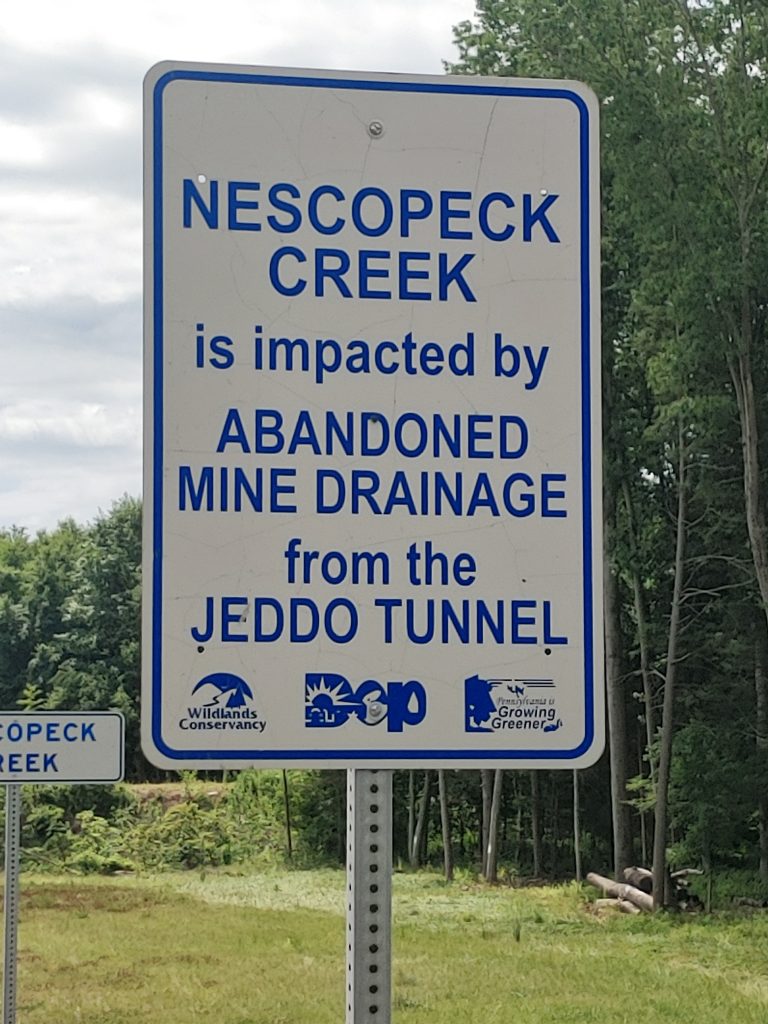Mike Sauers, July 18, 2022

The Jeddo Mine Tunnel is one of several environmental catastrophes that plague the Greater Hazleton Area. It ranks right up there with the Hazleton City Landfill debacle, the considerable list of past/present Superfund Sites, the devastation of thousands of acres of pristine wildlife habitat through coal mining and an equally devastating loss of wildlife habitat via industrial development. The Jeddo Mine Tunnel is a product of deep coal mining that was/is exacerbated by surface mining. In a nutshell, it was engineered and paid for by coal interests to keep surface and subsurface waters from flooding deep coal mining. It was designed to drain more than 30 square miles of land and cover four major coal basins. The normal flow volume from the tunnel is 40,000 gallons/minute. At times it has reached 100,000 gallons/minute. It never runs dry! That is a tremendous volume of water!
The Jeddo Mine Tunnel was, for all intents and purposes, abandoned in the 1950’s when deep coal mining was devastated by severe flooding. Since then the tunnel system has been impacted by 20 to 30 additional sites ( sinks, bore holes, cave-ins, surface mining, etc.) where surface and subsurface waters infiltrate. Abandoned mining operations have completely destroyed the natural surface water and ground water systems within the mining area. Ponds have disappeared. Wetlands have dried up. Parts of streams and creeks are gone. The water was diverted into the tunnel system. The Jeddo Mine Tunnel was touted as an engineering marvel. It took a long time for community leaders to recognize it as an environmental nightmare. For many decades the Tunnel has delivered vast quantities of acidic water containing magnesium, iron, aluminum and other toxic substances directly to the Little Nescopeck Creek in Butler Township. The Little Nescopeck Creek then pollutes the pristine Nescopeck Creek. Of course, this reaches the Susquehanna River and eventually the Chesapeake Bay. The Susquehanna River Basin Commission estimates that the Jeddo Mine Tunnel is responsible for 50% of all aluminum flowing into the river. Aquatic life is non existent.
There is plenty of blame, finger pointing and irresponsible leadership to discuss but I will leave that for a future post. However, there is a powerful message here for young people. PERSISTENCE pays off! PATIENCE is a virtue! NEVER give up! Over the past 40 years, dedicated individuals like Drew Magill and Alan Gregory to grassroots community groups like Friends of the Nescopeck, Middle Anthracite Watershed Association, Lower Anthracite Project, and Greenfire Coalition, to larger stakeholders such as Wildlands Conservancy, SRBC and EPCAMR have relentlessly advocated to address the Jeddo Mine Tunnel. Along the way flickers of hope appeared but never really amounted to much. Finally, in 2021, along came a bipartisan federal infrastructure law that allocates 245 million dollars a year for 15 years to address reclamation of abandoned mine sites which includes the Jeddo Mine Tunnel. The entire law is bipartisan but Bob Casey and Matt Cartwright deserve thanks for zeroing in on AMR and AMD. They have also introduced the STREAM Act which will provide funding for the maintenance of remediation projects. Kudos to them!
As you might suspect, that kind of money brings out a wide variety of players who want to promote their approach to remediating AMD and AMR. The mix ranges from interested citizens, like myself, to grassroots organizations to watershed associations to government agencies to private business interests. There are several approaches to remediation, however, for this post I am going to describe mine. First of all, I think mine is the most ecological approach. The first step would be to re-establish the natural surface water and groundwater systems to the extent that it is possible. That means plugging up as many sites as possible where surface water and subsurface water infiltrate the Tunnel. The re-establishment of wetlands (swamps, bogs, ponds, vernal pools) and creeks/streams would be the result of this first step. It would create wildlife habitat and natural landscape beauty to currently devastated mine lands. This would slow down/eliminate approximately 20 to 25 percent of water entering the Tunnel. There is a certain poetic justice in this since it was coal interests that created the problem. They should not complain. Secondly, given the consistently high volume of water exiting the Tunnel, a hydro-electric generating station should considered. At the very minimum, this could provide clean operating power at the site. Third, consideration should be given to systems that extract valuble metals, such as lithium, which can then be marketed. Fourth, direct as much Tunnel water as possible to a site appropriate, acid neutralization system. These systems involve lagoons, ponds and water channels were lime or other alkaline materials neutralize the acid water before releasing it back to the Little Nescopeck Creek.
Given the committed money and timeframe, the above approach is doable and maintainable. Stay tuned. Inform yourself. Make it an issue!
